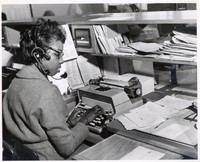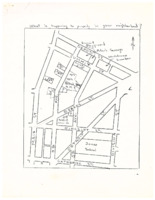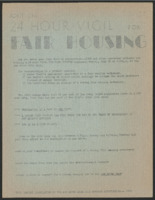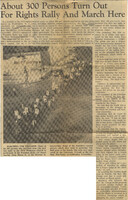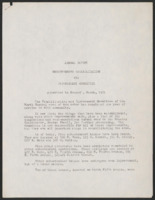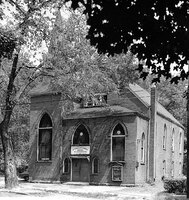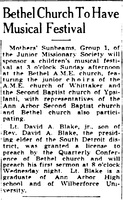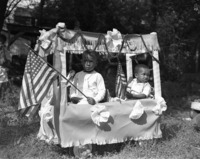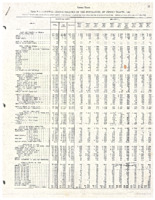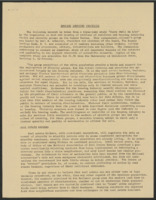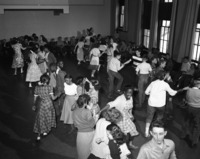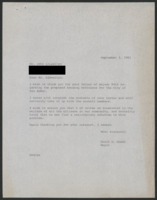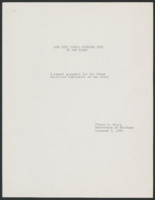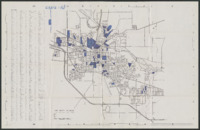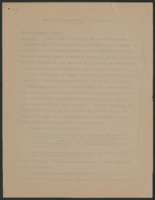Search
1 item set
29 items
-
Ann Arbor Fair Housing Ordinance (Proposed): Public Hearing / Ann Arbor Common Council; ([R289B]) - 1963 March 19
This audio recording features parts of one of the first hearings for the City of Ann Arbor’s proposed Fair Housing Ordinance. In the beginning of this clip, you can hear a speech in support of the ordinance by Albert Wheeler, who was representing the NAACP and would go on to become Ann Arbor’s first Black mayor in 1975 (Stanton, 2021). Wheeler describes many of the types of housing discrimination that Black residents of Ann Arbor faced in seeking homes. -
"What is happening to property in your neighborhood?” Flyer
This flyer from the Human Relations Commission warns Ann Arbor residents about multiple schemes designed to push residents to sell their properties and offers resources for getting accurate financial advice. One ploy mentioned involved a local landlord who was increasingly buying houses in the North Central Area, an act of gentrification which began changing the value of homes in the neighborhood (see “Related Item(s)” for more). -
24 Hour Vigil for Fair Housing Flyer
This is a flyer distributed by the Ann Arbor Area Fair Housing Association -- CORE to announce a vigil for housing that started on July 21, 1963. The document contains a list of action items for citizens to get involved in the push for a fair housing ordinance, ranging from contacting city councilmembers to influencing media coverage of support for such a measure. -
4 Mile March Protest - Protester With Sign "Mayor Opposes Fair Housing"
This photo for the Ann Arbor News portrays a demonstration along Summit St in the Northeast Central area of the city (4 Mile March Protest - Protester With Sign “Mayor Opposes Fair Housing,” n.d.). The action was organized to protest the support by city government - specifically Mayor Cecil O. Creal - for a weakened fair housing ordinance. The community members in this photo carry picket signs pointing out the government’s hypocrisy in investing in a plan, but only one that would be unactionable. -
About 300 Persons Turn Out For Rights Rally And March Here
This newspaper clipping describes a Freedom Rally sponsored by the Student Non-Violent Co-Ordinating Committee (SNCC) of over 300 community members marching from City Hall to the First Method Church near the University of Michigan’s Central Campus. This event, which featured John Lewis, was to precipitate the March on Washington for Jobs and Freedom that would take place the following day in Washington D.C.. At the start of the event, the SNCC was joined by demonstrators of the Ann Arbor Fair Housing Association - CORE who were continuing their advocacy for fair housing. -
All The Tables from Citizens’ School Report
In this newspaper clipping from 1964, the Ann Arbor News visualizes statistics from a report of the Ann Arbor Board of Education’s Citizens’ Committee, which was established to investigate how race was shaping the student populations of and educational experiences at various city schools (Jones School, n.d.). This article, one of six to be printed in the Ann Arbor News, reveals the ongoing segregation and racial violence enacted against Black students through the city’s primary education system. (All The Tables From Citizens’ School Report, n.d.). Notable statistics include the overwhelming separation of Black students into the Jones and Mack schools (which reported that Black students comprised respectively 75.4% and 41.1% of their student populations), as well as the educational neglect of Black students across the school system in regards to grades. The publication of the report these statistics come from ultimately led to broad support by civil rights groups and Black families in the North Central area to close the Jones School, as well as to restructure the city’s education system (Jones School, n.d.). It is important to note that absent from these statistics is contextualizing information about racism in the school system, such as the experience of Black students. -
Annual Report: Neighborhood Rehabilitation and Improvement Committee
This report created by the Rehabilitation and Improvement Committee of the North Central Area documents housing policies that were enforced within the neighborhood during the first year of the committee’s existence. As it seems the report may have been delivered to Ann Arbor’s City Council as an update (see the use of “Council” on page 1), it is important to note both the actions described in the report and how they are conveyed. Buildings are rarely, if ever, mentioned in the context of those residing or working in them, save for those whose residents received marks of compliance from the committee. Rather, homes and businesses are often reduced to structures that are “sub-standard” (page 1) or an “eye sore” (page 2) - a change of language that lenses actions to destroy them or gut them as benevolent and necessary. -
Bethel African Methodist Episcopal Church
This photograph depicts the exterior of the building which housed Bethel A.M.E. Church from 1895 to 1971 (Bethel African Methodist Episcopal Church, n.d.). While possibly older, this photo appears in a 1957 Souvenir Program provided by the Church in celebration of the religious organization’s centennial year (Bethel AME Church of Ann Arbor, n.d.). -
Bethel Church to Have Music Festival
This newspaper clipping advertises an upcoming sermon by Lt. David A. Blake, Jr., son of Rev. David A. Blake Sr., who served as minister at Bethel A.M.E. from 1933-1937 (David Addison Blake Sr (1887-1970), n.d.). As a central Black church of the North Central area, Bethel A.M.E served as a community stronghold for Black residents to discuss concerns about race relations and housing discrimination in the city (Shackman, 2000). Several notable community leaders came from the church, including Rev. David A. Blake Sr. and Rev. Lyman Parks, who later played a role in the desegregation of Ann Arbor public schools (Jones School, n.d.). -
Bethel To Hear Former Pastor
This newspaper clipping describes an upcoming sermon by Rev. David A. Blake, Sr. at Bethel A.M.E. Church. Bethel A.M.E. was a central location for the Black community of the North Central region of Ann Arbor, where community members met and discussed issues of housing and school segregation in the city (Shackman, 2000). Blake served as minister of Bethel A.M.E. from 1933-1937, known for hosting Race Relations Day events where multiple Black church congregations gathered to talk about community action surrounding racial discrimination in the area (David Addison Blake Sr (1887-1970), n.d.). He went on to join the board of directors of the Ann Arbor Cooperative Society and eventually was elected the first Black American to serve as a Board Supervisor in Ann Arbor as a Board Supervisor of the 4th Ward in 1951 (David Addison Blake Sr (1887-1970), n.d.). -
Criteria Worries Aired to Housing Commission
This newspaper clipping describes the proceedings of a Housing Commission meeting in Ann Arbor, which focused upon seeking Public Housing Administration funds to provide housing for economically disadvantaged members of the community. Of importance in this article is information from a letter written by Emma Wheeler, then-President of the local branch of the NAACP, about how housing rights are related to rights in education, especially for Black students who were displaced with the closing of the Jones School. -
Eldridge & Zonnechris Askew In The Bethel A.M.E. Nursery School Parade
This is a photograph of nursery school students Eldridge & Zonnechris Askew at a Bethel A.M.E. community event (Eldridge & Zonnechris Askew In The Bethel A.M.E. Nursery School Parade, August 1949, n.d.). Bethel A.M.E. was a stronghold of community gathering and action in the Black community of Ann Arbor's North Central area (Shackman, 2000). -
Excerpts from the 1960 Census of Ann Arbor
These two sheets of data were compiled during the 1960 Census and reflect population statistics for the city of Ann Arbor and the greater Washtenaw County. While Census data often fails Black and Brown people, it is critical to note how almost 40% of the recorded Black population of Ann Arbor was noted to live within Census Tract WA-0007, which roughly corresponds to the North Central and Northeastern areas of the city. Moreover, much can be gleaned from looking at the non-white populations and class dynamics of surrounding tracts to understand the shape of segregation in the city and county. -
Housing Industry Practices
This is a report of the First Presbyterian Church in Ann Arbor, Michigan which douments the various racist housing discrimination practices that were occuring in the city. Divided into three sections - "Real Estate Brokers," "Builders," and "Financial Institutions" - the document clarifies the various parties involved in upholding Ann Arbor's housing segregation. -
Jones School Students Square Dancing
This photograph depicts a racially-integrated school dance for students attending the Jones School in 1949. During this era, the school was involved in early attempts to integrate primary education by offering busing for white students from towns just north of Washtenaw county (Jones School, n.d.) (Monagan, 2019). -
Letter from Harriet Fusfeld
Directed towards the Human Relations Commission of Ann Arbor, this letter describes a variety of ongoing tacit policies creating barriers to fair housing in the city. Of importance is an anecdote on page 2 about a local landlord who constructed apartments out of various homes in Ann Arbor - all of which he neglected to service while keeping rent high (see “Related Item(s)” for more). Fusfeld notes that local organizations, such as the NAACP, were planning to work on or grow outreach efforts to residents to ensure their rights remained respected and protected. -
Letter from John Llewellyn
Written from Ann Arbor resident John Llewellyn to then Mayor Cecil O. Creal, this letter provides a racist argument against the potential passing of a city-wide fair housing ordinance. Of note is a mentioned housing facility at 307 N. State St. in Ann Arbor, where a racist landlord described to Llewellyn her use of a dog to intimidate potential Black residents. Attached to this letter is a response from Mayor O. Creal, which assures Llewellyn that his concerns are heard and will be taken into consideration by city government. -
Liberal Talk Not Enough to Change Schools’ Image
This article describes the state of educational segregation in Ann Arbor’s primary educational system in the 1980s. Mirroring the history of the school district from almost exactly twenty years prior, the Ann Arbor Board of Education established a Committee on Excellence to reassess how racial disparities continued to pervade the system. Of particular note are the mentions on page 1 of consistent rejections by the Board of proposed racial integration plans and on page 2 of the relationship between ongoing housing disparities and the educational system. -
Low Cost Rental Housing Need in Ann Arbor
This is a report prepared for the Human Relations Commission of Ann Arbor, covering various forms of housing discrimination that were occurring in the city. -
Map of Ann Arbor, Michigan
This is a map of Ann Arbor, Michigan from the files of former city mayor, Cecil O. Creal with annotations from an unknown person or collective. The blue highlighted regions indicate areas important to discussions about fair housing in the city, which mostly consist of areas on the north side of Ann Arbor. -
NAACP Civil Rights Profile - Ann Arbor Area
This annotated document is a comprehensive survey of the impact of racial discrimination on the lives of Black residents of Washtenaw County in the early 1960s. Created by the local chapter of the NAACP, this report was made for the purpose of informing local and national political figures about racial injustices ahead of a potential construction of an atomic laboratory in the area by the Federal Atomic Energy Commission. Annotations in the margins come from an unknown source. -
NAACP Demonstration
This annotated document was created by the Ann Arbor branch of the NAACP to alert citizens about the start of a weekly series of demonstrations for a more equitable Human Relations Commission in city government. The paper includes an overview of the causes for the demonstrations, standards for involvement, and additional related facts about city governance. Annotations throughout the document come from an unknown source. -
North Central Area Study -- Limited to Beakes, Depot, Main triangle
This report was made by Eunice Burns, a then member of the Ann Arbor Planning Commission, to look into the potential city purchase of various plots of land from a developer in the North Central area of the city (Michigan Historical Collections staff, n.d.). Given the context of purchase dates and areas, this seller is most likely the landlord who purchased a variety of units in the Beakes, Depot, Main triangle during the early 1960s (see “Related Item(s)”). Of note is that this item directly cites a report from Harriet Fusfeld to the Human Rights Commission several years earlier (see “Related Item(s)”). -
Parents Take Over School Head's Office in Willow Village
This newspaper clipping describes a demonstration by parents of students in the Willow Village school district, which covered an area developed in between Ann Arbor and Ypsilanti alongside the World War II era Willow Run factory (Sherman & Shackman, 1995)(Four Willow Run Schools Care For Great Influx, n.d.). Black parents of students in the system had organized themselves with the help of Rev. David A. Blake Jr. of Bethel A.M.E. Church to protest the potential move of Black students from the integrated Ross school to the segregated Simmonds school.
